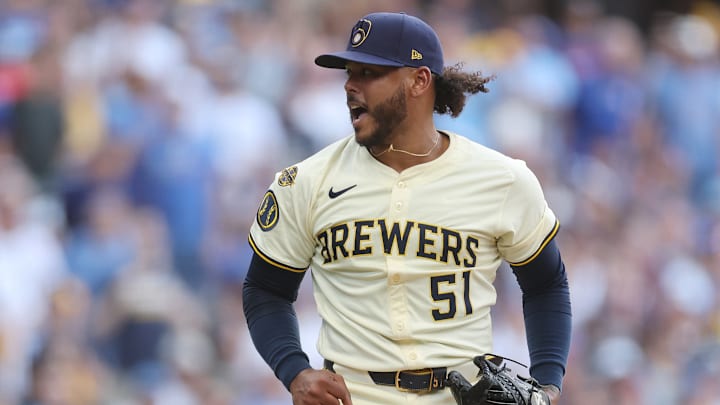If you follow the Milwaukee Brewers long enough, you learn to translate front-office dialect. The words are careful, the message is layered, and the subtext usually tells you as much as the headline. That’s the energy around Freddy Peralta right now. On paper, Milwaukee holds an $8 million club option for 2026, the final thread from the team-friendly extension Peralta signed back in February 2020. In practice, that option sits on top of a very Brewer-ish decision tree: maximize a frontline arm for a contender in 2026, or convert one year of an ace into multiple years of help elsewhere before he reaches free agency after the 2026 season.
Brewers newly-minted president of baseball operations and general manager Matt Arnold’s latest comments fit that push-pull perfectly. Asked about trading Freddy Peralta, he said it’s “not at the front of my mind.”
That isn’t slamming the door; it’s a reminder Milwaukee doesn’t operate in absolutes, especially while leverage is still building. Remember, as of June 2025, Peralta and Klutch Sports hadn’t gained traction on an extension, and Arnold didn’t rule out a deadline move even as they were tracking toward another NL Central title. Translation: the Brewers will do what’s best for the window, even if it isn’t the splashiest quote during the offseason.
Freddy Peralta trade chatter meets a reality check in Milwaukee
From a pure baseball standpoint, keeping Peralta is the cleanest path. He just authored one of his finest seasons: 2.70 ERA over a career-best 176 2/3 innings, with a 28.2 percent strikeout rate. The walk and barrel rates weren’t pristine, but that’s always been part of the Peralta profile; he still misses bats at a top-end clip and holds velocity late. On a team that plans to contend again in 2026, there’s real value in walking into April with an ace already atop the page and 27 outs feeling shorter every fifth day.
But this is also the Brewers, and their competitive edge is a portfolio, not a poster. Trading Peralta at last year’s deadline would’ve been a non-starter, wrong timing, wrong message to the room. Now? The calculus is different because the depth and cost control behind him look very real.
Interesting from Matt Arnold, on the possibility Freddy Peralta could be traded with one year left before free agency: "To be honest, it's not at the front of my mind."
— Adam McCalvy (@AdamMcCalvy) October 23, 2025
Jacob Misiorowski should be in that rotation for a full season. Logan Henderson and Robert Gasser are tracking as meaningful contributors when healthy. Chad Patrick is the kind of internal option who can give real innings if he takes the expected step. When you can blend an upside wave with steady veterans, the conversation naturally broadens from “can we survive losing Freddy?” to “can we use Freddy to upgrade the rest of the roster without collapsing the rotation?”
That’s the crux of the business model in Milwaukee: buy low (or early), develop relentlessly, and sell at peak if extension math stops making sense. Peralta would absolutely be worth an extension in a vacuum; he’s an anchor with strikeout stuff. But long, pricey pitcher deals haven’t been the Brewers’ preferred route. If they decide not to push into that tier, one year of Peralta at $8 million becomes one of the sport’s most attractive trade chips. You don’t move that just to move it; you move it if it lands multiple years of impact, ideally a bat that lengthens the lineup or a premium defender who raises the daily floor, plus a near-ready arm to keep the innings ledger balanced.
There’s also timing leverage. Milwaukee doesn’t need to advertise availability in October or November. Let the market shape itself, free-agent prices, other clubs’ whiffs, early-winter injuries, and then force suitors to pay for certainty.
Peralta is top-tier certainty at a mid-tier salary. That’s how you convert one year into three or four controllable ones without punting a season. And if that market never materializes at the level Arnold wants? Great. You pick up the option, you roll into 2026 with a Cy Young-caliber No. 1, and you reassess in July.
None of this undercuts the simplest answer: keeping Freddy Peralta might be the Brewers’ best move because it’s the most direct route to winning the division again. But the reason Arnold can publicly “downplay” a trade while privately gaming scenarios is because Milwaukee’s structure allows for both truths at once. They can be better with Peralta in March and still open to being different and deeper if the return in January or June is undeniable.
So where does that leave us today? Exactly where the Brewers like to live, on the efficient frontier. If an extension number suddenly makes sense, don’t be shocked if they grab it. If a true haul appears, don’t be shocked if they listen. And if the status quo is the best path to 90 wins, expect Peralta taking the ball on Opening Day without much noise from the podium.
